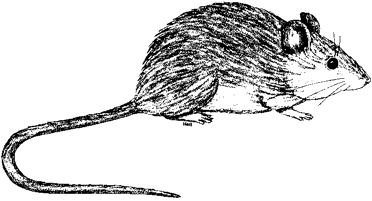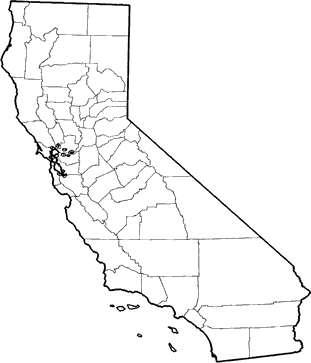
Salt-marsh Harvest Mouse
Distribution, Abundance, and Seasonality
Found only in saline emergent wetlands of San Francisco Bay and its tributaries. The northern subspecies R. r. halicoetes is found on Marin Peninsula, through Petaluma, Napa, and Suisun Bay marshes, and in northern Contra Costa Co. The southern subspecies R. r. raviventris mostly is restricted to a band extending from San Mateo Co. and Alameda Co. south along both sides of San Francisco Bay to Santa Clara Co., but isolated populations occur in Marin and Contra Costa cos. Pickleweed saline emergent wetland is preferred habitat (Shellhammer 1977), where it may be locally common. Grasslands adjacent to pickleweed marsh are used, but only when new grass growth affords suitable cover in spring and summer months (Fisler 1965, Shellhammer 1982).

Range Map
Specific Habitat Requirements
Feeding: Little data, but probably subsists on leaves, seeds, and stems of plants found in the salt marsh. Much seasonal variation in stomach contents (Fisler 1965). In winter, fresh green grasses preferred. The rest of the year, pickleweed and saltgrass are main food sources. The herbivorous diet of R. raviventris in comparison with R. megalotis is reflected in a significantly greater intestine length (Fisler 1965).
Cover: Uses pickleweed as primary habitat. Value of pickleweed increases with depth, density, and degree of intermixing with fat hen and alkali heath (Shellhammer 1982).
Reproduction: Does not burrow. Nests of grass and sedge built on ground associated with R. r. halicoetes, and are similar to those constructed by R. megalotis. R. r. raviventris does little nest building, but may construct loosely organized structures of dry grasses (Fisler 1965, Shellhammer 1982).
Water: Free water is required, but both subspecies are capable of drinking salt water. R. r. halicoetes is capable of drinking pure sea water (Fisler 1963, Haines 1964), but R. r. raviventris selects water with salinities between fresh and sea water, leaning toward sea water (Fisler 1963,1965). The differences probably relate to the normal salinity levels in the salt water available to natural populations.
Pattern: Pickleweed is the primary habitat, but non-submerged, salt-tolerant vegetation for escape during highest tides is essential (Shellhammer et al. 1982).
Species Life History
Activity Patterns: Primarily nocturnal, but 15-20% of daily activity recorded under laboratory conditions was between sunrise and sunset (Fisler 1965). Most of this daylight activity occurred in the afternoon. R. r. raviventris can become torpid, particularly in the early morning hours. Neither R. r. halicoetes nor the closely related R. megalotis shares this characteristic (Fisler 1965).
Seasonal Movements / Migration: Some movement of individuals from pickleweed marsh to higher grassland occurs in the spring and summer, or otherwise as plant cover affords escape from predators. These movements are likely to occur daily and do not represent complete shifts in habitats. The movement of individuals between marshes does not seem to occur (Shellhammer 1977).
Home Range: No data found.
Territory: No data found.
Reproduction: R. r. raviventris breeds mostly from March to November. R. r. halicoetes breeds from May to November (Fisler 1965). Litter size averages about 4 young for both forms. R. r. raviventris may produce 2 litters each year, though the shorter breeding season for R. r. halicoetes suggests this form has one litter per yr (Fisler 1965). No data on weaning or sexual maturity.
Niche: Distribution and abundance dependent on availability of dense pickleweed salt marsh. Both subspecies occur with the closely-related, ubiquitous and abundant western harvest mouse, at upper edges of marshes, and in marginal areas. Both may be found in pickleweed, though R. raviventris excludes or replaces R. megalotis in denser stands. The abundance of R. megalotis increases with increasing predominance of annual and perennial grassland. Predators include owls (Johnston 1956), hawks, gulls, weasels, and other mammalian predators.
Comments: The endangered status of R. raviventris largely results from commercial and residential development around San Francisco Bay, causing loss of pickleweed habitat. Marsh loss is attributed mainly to filling, diking, subsidence, and changes in salinity (Shellhammer 1982). R. raviventris has been especially affected by habitat loss. Vegetational changes over the last 3 decades, notably the increase of bulrush and saltgrass, and the decline in pickleweed, attributed to changes in salinity of the marshes, brought about by increasing volumes of sewage water, as well as subsidence-related causes (Wondolleck et al. 1976, Shellhammer 1977).
Sources & References
California Department of Fish and Game, 1999.
California's Wildlife, Sacramento, CA.
Written by: P. Brylski, reviewed by: H. Shellhammer, edited by: R. Duke
Fisler, G. F. 1963. Effects of salt water on food and water consumption and weight of harvest mice. Ecology 44:604-608. Fisler, G. F. 1965. Adaption and speciation in harvest mice of the marshes of San Francisco Bay. Univ. Calif. Publ. Zool. 77:1-108. Haines, H. 1964. Salt tolerance and water requirements in the salt-marsh harvest mouse. Physiol. Zool. 37:266-272. Johnston, R. F. 1956. Predation by short-eared owls in a Salicornia salt marsh. Wilson Bull. 68:91-102. Shellhammer, H. 1977. Of mice and marshes. San Jose State Univ. Studies 3:23-35. Shellhammer, H. 1982. Reithrodontomys raviventris. Mammal. Species No. 169. 3pp. Shellhammer, H., R. Jackson, W. Davilla, A. Gilroy, H. T. Harvey, and L. Simmons. 1982. Habitat preferences of salt marsh harvest mice (Reithrodontomys raviventris). Wasmann J. Biol. 40:102-114. Wondolleck, J. T., W. Zolan, and L. Stevens. 1976. A population study of harvest mice in the Palo Alto Salt Marsh. Wasmann J. Biol. 34:52-64. Zetterquist, D. 1978. The salt marsh harvest mouse (Reithrodontomyus raviventris raviventris) in marginal habitats. Wasmann J. Biol. 35:68-76.
California Animal Facts | California's Wildlife